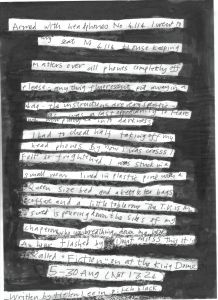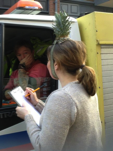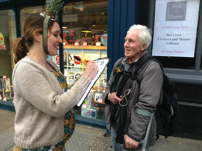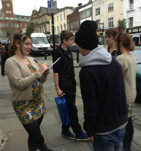This month marks the end of NTiYN as a research project, and the beginning of this work as a practice for life. Over on the Fuel website is a page of useful stuff that we’re hoping to share with as many people as possible: an evaluation booklet which discusses the ways in which the project was successful and not so much; the essay of historical precedences that I keep banging on about (sorry! It’s full of others’ good thinking and I’d love people to read it); and handbooks related to the two chief discoveries of the project, with suggestions for how to run theatre clubs and how to work with local engagement specialists.
The Theatre Club handbook I’m super proud of (and no, I didn’t write it!): ever since Lily Einhorn invited me to start hosting one as part of the participation project at the Young Vic in London, it’s been a mystery to me why every theatre in the country doesn’t offer one as part of its events programme. All it involves is opening up a space for audiences to talk about theatre shows without the people who made them present: it doesn’t have to replace the Q&A, in fact it’s best when the two are complementary. But it invites people to speak and be heard who often feel excluded from what looks like a theatre clique, through worry that they don’t have the right language or haven’t understood something. At Theatre Club, it’s brilliant when people don’t understand something, because often that’s when individual interpretations based on particular experiences begin to emerge. The best part of being involved in NTiYN for me has been watching people start up theatre clubs of their own, and through that forging social groups that get people going to the theatre more, in buildings they might not have visited before, and to see work they might not have taken a chance on, especially if they were likely to be attending alone. It’s through such groups that theatre can become less an occasional outing and more the fabric of life.
The people who have been instrumental in inspiring those groups to begin are the Local Engagement Specialists: people who live and work in the vicinity of the theatres to which Fuel tour, who form a point of connection between Fuel/the theatre-makers, the venue and the local communities. During the course of the research project those have been paid positions; Fuel have made the decision to use what they’ve learned to shape a volunteers network, but a necessary question was raised at the NTiYN closing event in Preston last month by Charlotte Bennett, producer with RashDash who runs a similar volunteer ambassador scheme, about the ethics of asking people to do that work for free. As an aside, that closing event was fascinating in the way that it brought people from all sections of the theatre industry – from the artistic director of the Royal Exchange, Manchester to independent producers, makers, actors, students, and the enthusiastic audience members who are Fuel’s new volunteers – into a room for a shared conversation in which a genuine attempt was made to scrub away hierarchies so that all opinions were equally valid. As mentioned on the home page, I came to NTiYN via Dialogue, an organisation (although that’s not quite the right word for it – it’s more a philosophy) that aims to inspire new relationships between people who make, watch and write about theatre. As you can tell from the name, dialogue is at the heart of what we do and think about, and this was a beautiful instance of how a theatre conference could be more egalitarian and creative in its structure. (And, yet another aside, there’s a lovely review of the event here by Olivia Corbin-Phillip, one of the new Colchester volunteers.)
I want to end by talking more about the Local Engagement Specialists, but rather than pull extracts from the handbook, I’d rather let them speak for themselves. Earlier this year I spoke to Jordana Golbourn (Colchester) about her experiences within NTiYN, how it had gone well and what might have been improved. As the only Local Engagement Specialist who stayed with NTiYN for the entire three years, she has a sense of overview that all the others lack. I’d argue that her staying power is in part down to the fact that outreach is the bedrock of everything she does: a freelance theatre-maker who runs projects at the Almeida and Make Believe Arts in London, among other venues, she works particularly with young people, using theatre as a tool to explore the issues relating to their lives. She’s also one of those people who talks so much sense and kindness that she ought to be in charge of everything.
Jordana already had a relationship with the Lakeside in Colchester when she became the Local Engagement Specialist there – and that proved as much a frustration as a benefit. “In the very initial stages of the project, I think they saw the relationship less as a collaborative thing, and more: ‘Jordana’s got this one.’ That was partly to do with how stretched they are as a venue – it’s just three people – so it was a relief to them to be able to have somebody who could work on some projects, and they trusted the model to make things happen.”
What that meant, however, was that: “I didn’t feel like I was doing anything in terms of outreach. I was just another marketing head for the show.” It felt like an opportunity was being squandered: “One of the biggest things [in theatre] is trying to get people out of the rut that they’re already working in. We’re really stretched, so to think of doing things in a different way is a job in itself.” In no way was this a problem unique to the Lakeside, and Jordana says: “It speaks volumes for where we are in theatre at the moment that people have not really grasped NTiYN as an opportunity to learn and reflect on their practice, and be part of something widely, across the country, but instead grasped at it as a bit more money for a bit of extra help.”
Her commitment to the project meant that she was able to trace the shift in approach at the Lakeside, the effect of the realisation that “actually collaborating with it works better”. Partly this happened because she became more assertive about the role she was willing to play: “I was really clear in the later stage that I’m not going to do marketing, I’m not going to take over your twitter handle: that’s your responsibility.” What she saw was that NTiYN “has made a real difference. When we first started, there was a lot of blanket marketing: everything went to everybody. They are now thinking show by show, and about who can we contact for each particular show.”
Communication problems with the venue were exacerbated by communication problems with Fuel. One of those was mechanical: email, it transpires, is a rubbish tool for planning outreach projects across multiple interested parties (to which we chant in chorus: WHO KNEW?). When Jordana says, “I’ve got a lot of love for google docs now,” she laughs at herself but is also sincere. “It lays out all the activity that we wanted to do and all the contacts and it’s really clear who’s doing what. Before using google docs, you’d have an initial meeting and everyone would go off and no one had a clear idea of what anyone was going to be doing.”
But the question of responsibility, and autonomy, isn’t just functional: it’s also emotional, and that proved harder to answer. Even in the final year of NTiYN, Jordana didn’t feel entirely clear what voice she was using as a Local Engagement Specialist. “Who are we speaking on behalf of, when we’re in that role? Am I supposed to be talking on behalf of the venue, or am I employed by Fuel? Do I feel like I have the same ownership over the work as the project managers at Fuel? Do I have enough weight to say: I’m Jordana, I’m a local theatre worker and enthusiast, and these are things I think are really brilliant and I think you should come? Is it OK to change depending on who you’re talking to? Because actually, different people might want different things: when contacting some of the schools I know really well, just being Jordana works, but for other schools that I don’t know so well, to be able to say, ‘I’m from this theatre company and this is what we do’ gives a weight that you need. I still haven’t worked out whether or not that flexibility is useful.”
These are perennial problems faced by freelancers: outsiders who are invited to behave like insiders, but without the privileges that might entail. And yet, in the context of NTiYN, it resulted in moments when barriers were put up between the Local Engagement Specialists and the touring theatre-makers that were not helpful for people attempting to do outreach work on those shows. Jordana recalls a research trip to a dress rehearsal in which the Local Engagement Specialists “didn’t get introduced to the artist or the production team”, creating a sense of distance between themselves and the makers. On another occasion, she didn’t find out that a performer in a show she had been working on grew up near Colchester until his parents came along to the theatre club: “That’s something we should have known and could have tapped into.” Earlier this year I spoke to Annabel Turpin, chief executive of the ARC in Stockton, and she discussed similar issues around communication, sharing of information and access to the artists. This has been one of the biggest learning points for Fuel: the realisation that sometimes they do form an unconscious barrier between artists, venues and communities.
The issue as Jordana sees it is in an industry-wide failure to really consider the question of responsibility when it comes to outreach and engagement. She remembers seeing a tweet by Alan Lane of Slung Low, distributing a photograph of one of the community actors in a show he was directing, Camelot, “going around the local community with posters, posing in the barbershop, having conversations. I thought: why is it only in community and amateur theatre where artists take this massive responsibility for promoting their work? Why is it only in those circumstances that people feel that it’s a proud thing to go out and tell people about it?” If she had her way, outreach wouldn’t be “someone else’s responsibility” but a collective endeavour – and the culture would be so much stronger for it.























